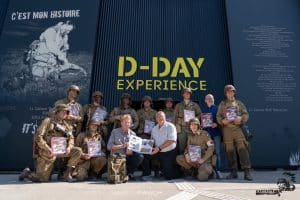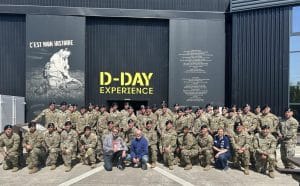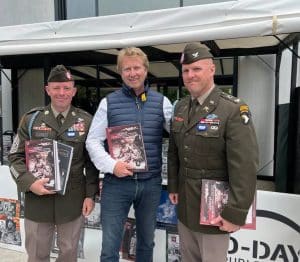Author
His history
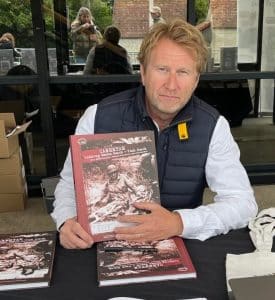
Michel De Trez was born in 1965. He has had an interest in WWII History since his early years. As a child, he started collecting artifacts left in the family home in Belgium by American soldiers. Among these, a canteen on which a name and a serial number can be seen: ‘Guth’. Quite naturally, when playing war games with the other children of his age, Michel called himself ‘Guth’. But who was this soldier? What could have been the motivation for these young Americans who had deliberately left their country, their family, all they had or liked, to risk losing everything to liberate us from the Nazi regime? Was he still alive? These are questions he often raised, but at the time there was no Internet and it was not easy to find someone living in another country.
At the age of 17, barely speaking a few words of English, he undertook his very first trip, alone, to the United States with the idea of meeting American veterans to gather their war recollections – and, who knows, maybe tracking down Mister Guth. His interest revolved
around the History of the US paratroopers with a specific interest in the wartime pictures depicting paratroopers and taken by war photographers. For month, he searched the records of the National Archives at Washington, D.C., listing and collecting pictures, classifying them by campaign, unit and attended numerous veterans’ reunions to identify, as much as possible, the men in these pictures and the location where they had been taken. A meticulous work of investigation was thus carried out and thanks to this passion, he was able to build up some unique collection of archives — maybe the world’s largest on the subject. Following a meeting with Cornell Capa, the younger brother of famous photographer and war correspondent Robert Capa, he was invited to the International Center of Photography, 5th Avenue, New York City and granted access to the prestigious collection of photos taken by Robert Capa for Life Magazine.
Nine years passed, and what about Guth you may think? Still no trace of him.
Michel had collected, identified and sorted out thousands of never-before-seen photographs that he wished to share with as many people as possible. To reach his goals, he planned on publishing them through a series of books covering the campaigns carried out by US
paratroopers in Europe. To complete this project in the best conditions, he founded his own publishing company: D-Day Publishing. Whilst writing his first book in 1992, he came across a photograph published in a book: Band of Brothers. A caption identified an American soldier in a photograph: Forrest Guth. Could it be the former owner of the canteen? According to the information provided by this book, Guth was of German descent and, like many German immigrants, his family resided in Pennsylvania before the war. A phone book on hand, a few phone calls and there Michel was on the line with Forrest Guth, whom he was to meet in person at his home a few months later. The writing on the canteen was definitely his, the Army serial number matched, there was no doubt — now he could tell the story: ‘In 1944, Forrest, a paratrooper, fought in Belgium…’
A great friendship developed between the young man and the veteran – a friendship that would lead to the writing of Forrest’s biography. The formation in which Forrest fought across Europe was the 101st Airborne Division, undoubtedly the most famous formation in the entire US Army. The latter was soon to become the one Michel De Trez would specialize in. The two men regularly met, traveling together in Europe and to the United States. Forrest introduced Michel to his brothers-in-arms and helped him collect stories, photographs, testimonials, and objects. The artifacts would illustrate his publications: these were no longer justsome random canteen, helmet or jacket, they were now unique objects with a story to tell. And this was the story Michel wanted to share.
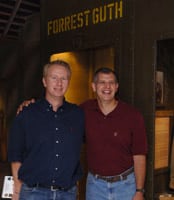
Michel de Trez and Col. Rob Dalessandro, U.S. Army Ret, Former Director US Army’s Heritage.
He then published numerous books dedicated to the paratroopers, which soon became reference works on the subject. He contributed to many magazines. In the United States, at the opening of the Military History Institute, the US Army Heritage and Education Center, he
was, amongst many historians, the only European author to be invited to present his publications. His reputation would also earn him the Medal of Excellence from the Embassy of the United States of America for his contribution to the preservation and transmission of
the History of the United States, award him a citizen of honor certificate in Kentucky for writing the biography of a medic paratrooper (Doc McIlvoy), and give him the opportunity to work with famous director Steven Spielberg on several occasions
Two of his publications became part of the personal literature of the above-mentioned film director. When the latter produced Saving Private Ryan and the television series Band of Brothers, his team called upon the experimented author for technical advice and supply of
suits and military gear. Strangely enough, it is the history of Forrest Guth’s company that Spielberg was telling.
Throughout many encounters with veterans, the author always kept in mind the idea of opening a museum in the area where the US airborne units had fought, and he built up an impressive collection of objects donated by the veterans he met, who believed in his passionate projects. These men willingly offered their invaluable keepsakes away to be later preserved and exhibited at the very spot they fought in, and he therefore held what he believes is the largest collection of military artifacts on this specific subject. ‘It is essential to pass on all this History and after publishing, there is no better option than exhibiting’, the author thinks. In 1994, on the occasion of the 50th anniversary of D-Day, he travelled to Carentan, the first major town liberated by the 101st Airborne Division, and set up an exhibition for four months. Visitors were impressed by the historic wealth of the exhibits. The local administrative body wished to see this collection – a heritage linked to the landings in the area – stay on the territory. But where to find the funds to build a museum? No public funds appeared to be available to permanently exhibit these private collections. And a question remains: how to seek funding and build a museum? No public sourcing seemed readily available to exhibit these private collections on a permanent basis.
In 2004, during the 60th anniversary of D-Day, the author successfully collected a budget of € 100,000 thanks to the sales of his publications, which he dedicated entirely to an exhibition called The Greatest Generation taking place in Sainte-Mère-Église. The author made a
presentation of his latest publication: Sainte-Mère-Eglise – Photographs of D-Day. Large display cases were put in place under a 1,000 square-meter tent. Forrest was here and for the first time, he saw a mannequin created to resemble him, in the spirit of Tussaud’s and Grévin museums. The mannequin was wearing his D-Day uniform and gear.
Later, in his pursuit of finding out the story of objects and photographs, Michel found himself on the Normandy landing beaches, accompanied by another specialist on the subject, Emmanuel Allain. His eyes crossed a sign reading ‘For sale’ on a house of which he knew the story: the mansion known as the ‘Dead Man’s Corner’. This house, located in Saint-Côme-duMont, was visible on page 139 of their bedside book, Rendezvous with Destiny — the official story of the 101st Airborne Division, published in 1948.
Right away, Michel knows that he doesn’t bump into this villa by chance. This will be the future Museum that he had dreamed of for decades. In June, 2005 twenty-six American veterans and a German veteran inaugurated the Dead Man’s Corner Museum which he has just opened with his new partner Emmanuel Allain.
The place evolved over the years and became the D-Day Paratroopers’ Historical Center—a museum and a historical route on the battlefield of Carentan. Their motto: it is the quality and story of exhibits that matters, rather than the quantity of artifacts on display. This was an easy task for someone who had spent part of his life collecting these items along with their stories directly from the veterans who had experienced what would be called the biggest event of the
20th century.
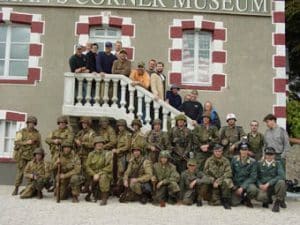
Cast of Brothers in Arms produce for History Channel, in front of Dead Man’s Corner Museum.
This mansion overlooking Carentan is located at the heart of the battlefield of the 101st Airborne Division. No sooner had the museum opened that it was in the spotlight. Gearbox Software and Ubisoft, two huge video games companies, had reproduced it with great accuracy in their new production inspired by the history of the 101st Airborne Division. A partnership between the giant company and the small museum was established and the museum went on to collaborate closely with Colonel John Antal in the production of a documentary for History Channel, narrated by American actor Ron Livingston.
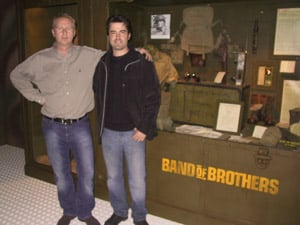
Ron Livingston, portraying Nixon in the HBO miniseries Band of Brothers, with the author.
The small museum shook up the habits. This new and unprecedented approach fascinated lots of visitors, such as Mathieu Steffens, a young Belgian collector of barely 24 years, who had founded a museum in Baugnez on the site of the notorious massacre of Malmedy. Both men share the same vision of what a war museum should be like nowadays. In 2012, with the enthusiasm of his youth, Mathieu led Michel into the taking over of the Museum of La Gleize. Founded by Philippe Gillain, Gérard Grégoire, the Municipality of Stoumont-La Gleize and the Province of Liège, the latter was about to close its doors.
After nine months of intensive work, the surface had doubled in size, a new museography was set up and the collections had been enriched, leading to the opening ceremony on June 20, 2013, in the presence of an American veteran who had fought at La Gleize, and the daughter of the founder of the museum, Marie Gillain. Strangely enough, it is Steven Spielberg who had given the talented Belgian actress her first desires for cinema.
The story does not end there. Some more publications followed, along with wartime photographs and artifacts. And sometimes, these could be pretty big, such as a tank or an airplane! And without knowing it, it is Spielberg again who was to become the instigator of the project. Being in the studio during the shooting of the Band of Brothers series, the expert in uniformology arranged to buy one of the aircraft. Spielberg had transformed a genuine C-47 into a TV set and mounted it on small jacks. This had given the two companions of Dead Man’s Corner a crazy idea. ‘What if we were to build a high-tech flight simulator with special effects, 3D screens, odors, smoke, flames, impacts, and amplified movements? A simulator which could carry 27 visitors over the Channel as it caried 27 paratroopers during the mythical crossing of June 6, 1944?’
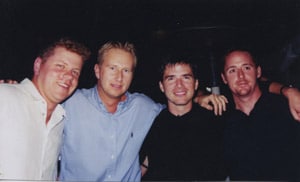
The actors of Band of Brothers and the author. Michael Cudlitz (Bull Randleman), Michel De Trez, Matthew Settle (Capt. Ronald Speirs) et Scott Grimes (Don Malarkey).
Simulating the sensations of a flight, over thirty times a day, seven days a week, with an actual aircraft which had not been designed at all for being lift on a single point, was a somehow ambitious project and a technological prowess. If we want to put ourselves in the shoes of a paratrooper on D-Day, it must be perfect. ‘If we want to honor what these men have been willing to do for us, there is no room for amateurism.’ The companions surrounded themselves with the best people in the field, those who conceive high thrills attractions for the largest amusement parks of the world. This required more than a year of study and many feasibility test. Was it achievable, or was it just a dream? Was it possible to lift these tons of steel, aluminum and passengers more than 10,000 times a year without damaging the frame?
On June 6, 2015, commemorations took place to mark the 71st anniversary of D-Day. Crowds were flocking to Saint-Côme-du-Mont. A gigantic building in the shape of a hangar had been built near the Dead Man’s Corner, just behind the small museum. Two ingenuous people were going to draw the public there, and €6,000,000 of private funds had been necessary for this small whim. The daughters of the pilots who had flow the Stoy Hora on June 6, 1944, came quite specifically from the United States to cut the ribbon which prevented the numerous guests from seeing what was inside. The visitors entered a pre-show, were briefed by a 3DColonel and then pushed a door. And here was the Stoy Hora. 71 years later, she was ready to fulfill her D-Day mission again. The honor given to both pilots, Colonel Frank Krebs and Major Howard Cannon, was invaluable. The emotions felt by the daughters wee unique. Innovation and technology were everywhere. Colonel Wolverton, a paratrooper who had met a tragic destiny at Saint-Côme-du-Mont, was chosen to tell the story throughout the museum.
The D-Day Experience had opened its doors. Over 75,000 visitors came and tested the flight simulator during the first year, and the impressions were unanimous: we feel as if we were there. The supreme consecration came when veteran Jim ‘Pee Wee’ Martin, after a simulated flight, declared with an enormous emotion: ‘I never thought it would be possible to relive it. I found myself 71 years back. It istotally unbelievable, everything isthere. How did you manage it?’
